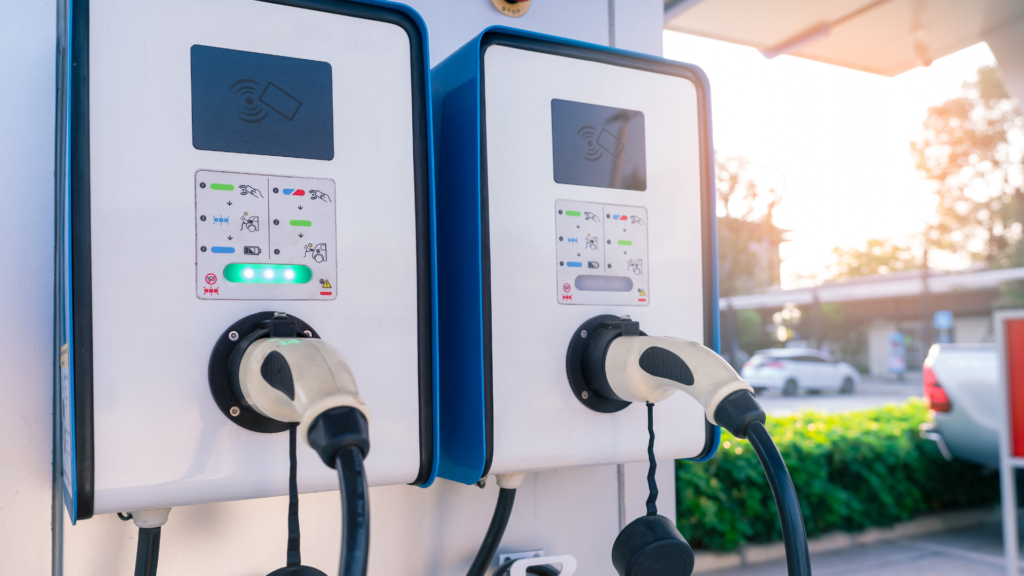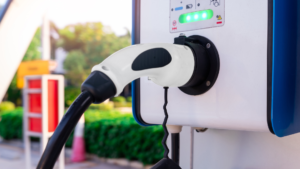How do EV Charging Stations Work ? Quick Guide

Introduction
Electric vehicles (EVs) are becoming increasingly popular as the demand for sustainable transportation grows. However, one of the main concerns of potential EV owners is the availability and accessibility of charging stations. EVs require charging stations to recharge their batteries, just as conventional cars require gas stations to refuel.
EV charging stations work by supplying electricity to an EV’s battery for it to operate. In this article, we will examine How do EV Charging Stations Work, the different types of EV charging stations, How to install EV charger at home and their benefits.
Types of EV Charging Stations
EV charging stations can be categorized by the amount of electricity they provide and the speed of charging. These types include Level 1, Level 2, and DC fast charging.
Level 1 Charging – This is the most basic type of EV charging station and provides the lowest amount of electricity. This level of charging is accomplished by plugging the EVs charging cable into a standard 120-volt outlet. However, this type of charging is slow and can take up to 20 hours to fully recharge an EV.
Level 2 Charging – This type of EV charging station supplies higher amounts of electricity compared to Level 1. Level 2 charging stations are typically found in public charging stations, commercial buildings, and residences. They require a dedicated 240-volt circuit and can deliver up to 25 miles of range per hour of charging.
DC Fast Charging – DC Fast Charging, also known as Level 3 charging, provides a higher voltage and current than the previous levels mentioned. This type of charging is typically found along highways and major roads and can deliver up to 80% of an EV’s battery in just 30 minutes.
How Do EV Charging Stations Work?
First, an EV owner must connect the vehicle charging port with the charging station. The charging station then communicates with the driver’s EV, coordinating with the on-board charging system to manage the charging process securely.
The charging station communicates with the vehicle using various protocols such as the Open Charge Point Protocol (OCPP). This protocol is used to manage charging sessions, monitor charging status, and manage the availability of the charging station.

The process typically involves plugging a cable into the car’s charging port which is usually located on the side or rear of the vehicle. The cable is then connected to an outlet or a charging station. Depending on the battery capacity and the charging rate, charging can take from a few hours to several hours before the battery is fully charged. Some modern electric vehicles also feature regenerative braking that can partially recharge the battery while the car is in motion, thereby increasing its range.
Once the charging process is complete, the charging station notifies the EV owner to unplug their vehicle from the station. The charging station also sends a receipt to the EV owner by email, indicating the amount of electricity consumed and the total cost.
How to install EV charger at home ?
While public charging stations have become more common, having an EV charger installed at home is an excellent way to ensure that your EV is always charged and ready for use.
Here is a step by step guide on how to install an EV charger at home:
Determine the Type of EV Charger You Need
The first step in installing an EV charger at home is to determine the type of charger that suits your needs. Broadly, there are two types of EV chargers: Level 1 and Level 2 as discussed above.
Choose the Right Location
Once you have determined the type of charger you need, the next step is to choose the right location for your EV charger. Factors such as proximity to the EV parking spot, availability of an electrical source, and appropriate safety measures should be considered.

For example, if you plan to install a Level 2 charger, you should ensure that the location has a 240-volt electrical source that can handle the charging load. Additionally, the location should be close to the EV parking spot to avoid any accidents while charging.
Prepare the Electrical System
Before installing an EV charger, it is essential to prepare the electrical system. This involves installing a new electrical circuit or upgrading your existing electrical system to accommodate the charging load.
For a Level 2 charger, a licensed electrician will need to install a dedicated 240-volt circuit and hardwire the charger to the main electrical panel. The installation of a circuit breaker and a ground fault circuit interrupter (GFCI) outlet should also be considered.
Install the EV Charger
Once the electrical system is ready, the next step is to install the EV charger. Most EV chargers come with a set of instructions, but it is always recommended to hire a licensed electrician to handle the installation process.
The process involves mounting the charger on the wall or pedestal and appropriately connecting the wires according to the manufacturer’s instructions. This is a crucial step, and any mistake made during installation can be dangerous and cause damage to the EV.
Test the EV Charger
After the EV charger has been installed, it is essential to test it to ensure that it is functioning correctly. Most EV chargers come with a test mode to determine the charging capacity and to ensure all the connections are correctly installed.
Additionally, it is important to ensure that the ground fault circuit interrupter (GFCI) is functioning correctly to minimize the risk of electric shock.
Final Inspection
The final step involves a thorough inspection of the EV charging system by a licensed electrician to ensure that it meets all the local codes and regulations. This inspection will ensure that the installation is safe, up to code, and will not cause any damage to your EV.
Benefits of EV Charging Stations
EV charging stations offer several benefits to both the EV owner and the environment. Some of these benefits include:
Cost Savings – EV owners can save money on fuel expenses compared to conventional fuel cars. Additionally, EVs require less maintenance than conventional cars, resulting in further savings.
Environmental sustainability– EVs produce zero or fewer emissions, making them an environmentally-friendly alternative to conventional vehicles. Charging an EV through sources such as solar energy also contributes to reducing carbon emissions.
Energy security– EV charging stations allow EV owners to recharge their vehicles: reducing the dependence on gasoline, oil, and the volatility of global energy prices.
Conclusion
EV charging stations will continue to play a crucial role in the transition of transportation towards sustainability. It is expected that the demand for electric vehicles and charging stations will increase over the years, and governments will need to collaborate with organizations and businesses to create an infrastructure that can cope with the growing demand.
In summary, EV charging stations are an essential component of the EV ecosystem. They offer a way for EV owners to keep their vehicles powered up and travel long distances without concerns of running out of power. With the increasing demand for sustainable transportation, the demand for EV charging stations is only set to grow in the future, creating a cleaner and more sustainable world for all.

With a degree in Electrical Engineering and years of hands-on experience in the tech industry, passionate to provide readers with insightful reviews. From smartphones and laptops to smart home devices and emerging technologies, he navigates the ever-evolving tech landscape, offering in-depth analyses and honest opinions.

![3d_printed_art_01[1]](https://techreviewly.com/wp-content/uploads/2025/08/3d_printed_art_011-300x225.jpeg)
![a_women_wearing_a_smart_watch_01[1]](https://techreviewly.com/wp-content/uploads/2025/08/a_women_wearing_a_smart_watch_011-300x169.jpeg)






